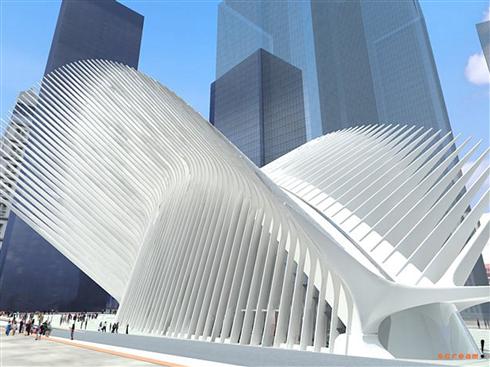The building will be tangible, but it's value will be in how humanity chooses to interact with itself inside.
Sometime next year an extraordinary building will open it's doors and tens of thousands of people will press to pass through. Before they do, however, there will be inevitable VIP events and champagne toasts. Corks popping will make a short-lived media splash, but history will not widely remember those celebrations. For many thousands of people the new train station beneath the ghost of the former World Trade Center in New York City will be a way-station on daily trajectories between work, home, and all the many places in between. No doubt a portion of those masses will marvel at the inspiring subterranean space. Artful architecture and modern urban planning rarely share much these days, with budgets endlessly tight because of scant, sad public willingness to invest in enterprises that don’t present immediate, tangible returns-on-investment.
This place is supposed to be different. The brain-child of renowned Spanish architect Santiago Calatrava, the World Trade Center Port Authority Trans-Hudson Transportation Hub (WTC PATH) transit terminal has been designed as a declaration of humanity’s churning, ceaseless energy, and its relentless need to move. In so doing it also becomes a statement of optimistic resolve and a repudiation of the terror that gripped the city above at the turn of the century . That the transit station will provoke many to stop in their tracks and consider the context of space and circumstance rising from the very spot where the Towers fell only amplifies the value of committing public money to making our living spaces more than merely functional.
During the actual construction of the place, remarkable discoveries were made on the site, including a wooden sailing ship centuries old. There has been lots of living done in this very spot; we might not have known about much of it had there not been horrific cause to see what lay beneath. The discoveries remind us that none of us every really know how long any of us will be tenants anywhere.
The transit station project has been monstrously contentious, as big projects are wont to do. Fights over form, function, authorship, and ownership have made it hard to complete beyond the obvious challenges of simply building the audacious, daring structure. But the people who’ve been actually hammering the thing together are proud, and like Pygmalion’s Galatea, the place is starting to become more real and more moving with every new girder and lighting fixture.
Soon it will open. Soon. When it does and the world floods in on hurried feet, ubiquitous video, and endless photographs, few people will notice a vital feature of the space, moving in silent sync .
Inside the massive construction, even before the official “Day 1”, will be an unsung retinue of labor who seem to embody the place as if they had been there for decades. Impossible, of course – – the paint isn’t even dry yet—but they’ll be present from the moment it opens. For the many custodians and janitors and facilities maintenance people there comes a wearying knowledge that those many travelers and photographers and lookie-loos who pass through with wide child-like eyes will hardly notice them at all.
You know who I’m talking about. These are the folks who will inevitably be pushing grey, hard rubber custodial carts filled with bottles of solvents and cleaning fluids, rubber gloves and paper towels. They will have faces lined with tired streaks like worn out stream beds, aware that their days in this gleaming, vital transit jewel will almost never take them on the journeys of the more colorfully dressed masses around them. In rough green or grey work pants hanging askew from their hips like ill-hung paintings, they’ll spend their days cleaning up after the masses of the many people scurrying to catch trains and taxis. They’ll know where the carefully sequestered supply rooms are and where to attach their discrete hoses for bigger clean up jobs. They’ll have an out-of-sight break room where they’ll leave their winter coats in January, and there will also be a manager’s office somewhere where they’ll go to ask for the day off one Sunday afternoon to attend their niece’s first communion. They’ll keep the place functional and organized; they’re the blood of its operations, and like blood, they’ll likely be invisible most of the time.
In the main hall the ceiling will soar above everyone, underground, with near magical light shining on opportunities and courageous perseverance and solidified resolutions of city officials, consultants by the score, and financiers. The transit station will declare the power of some, but it will profoundly serve the diverse needs of all.
The place is not yet open, but if you take a quiet moment and consider what’s coming, this should not be a surprise: the space will be a collision of imaginings. Lives that would not normally cross will intersect everyday. They may already do so now in a million ways everyday, all over the world, but here in this rare, gleaming new space, those imaginings will be given brightly lit, freshly scrubbed visages. Would that we stop once in a while, from whichever group we may happen to be, and notice how they all intersect, and share in the process of making mere steel and stone something that lives and breathes.
@michaelstarobin
facebook.com/1auglobalmedia

